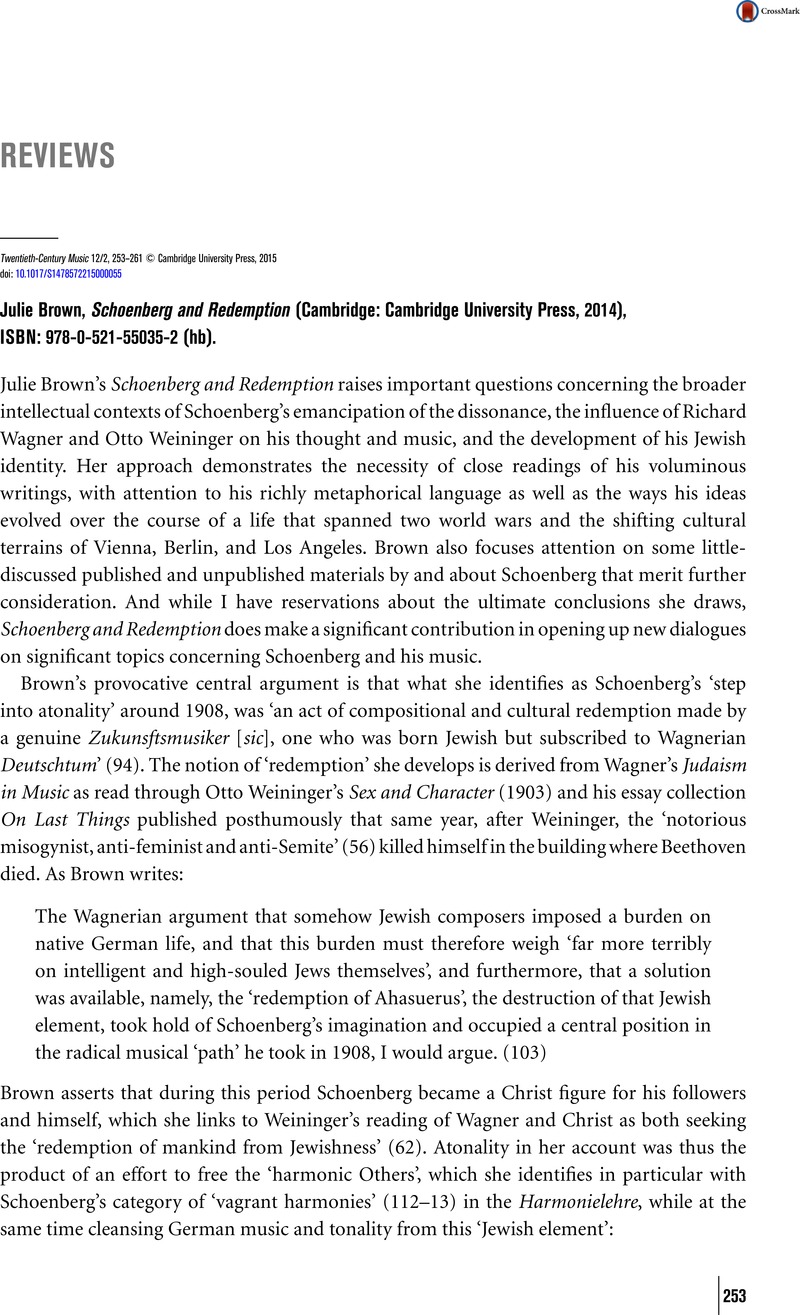No CrossRef data available.
Article contents
Julie Brown, Schoenberg and Redemption (Cambridge: Cambridge University Press, 2014), ISBN: 978-0-521-55035-2 (hb).
Published online by Cambridge University Press: 26 August 2015
Abstract

- Type
- Reviews
- Information
- Copyright
- Copyright © Cambridge University Press, 2015
References
1 The Mailamm lecture is included in Schoenberg, Arnold, ‘Two Speeches on the Jewish Situation’, in Style and Idea (Berkeley: University of California Press, 1975), 502–5Google Scholar. Also see Feisst, Sabine, Schoenberg's New World: The American Years (Oxford: Oxford University Press, 2011), 88CrossRefGoogle Scholar.
2 Later works she cites that employ the category of ‘breakthrough’ include Bekker, Paul, Gustav Mahlers Sinfonien (Berlin: Schuster & Loeffler, 1921)Google Scholar and Adorno, Theodor W., Mahler: eine musikalische Physiognomik (Frankfurt: Suhrkamp, 1960)Google Scholar.
3 For example, in a letter to Busoni from August 1909 during the time he was composing the Three Pieces for Piano, Op. 11, Schoenberg writes: ‘My music must be brief. Concise! In two notes: not built, but expressed!!’ Auner, Joseph, A Schoenberg Reader: Documents of a Life (New Haven: Yale University Press, 2003), 70CrossRefGoogle Scholar.
4 See Frisch, Walter, ‘Epilogue: Developing Variation in Early Schoenberg, 1892–1905’, in Brahms and the Principle of Developing Variation (Berkeley: University of California Press, 1984), 157–70Google Scholar.
5 Brand, Julian, Hailey, Christopher, and Harris, Donald, The Berg-Schoenberg Correspondence: Selected Letters (New York: W. W. Norton, 1987), 139CrossRefGoogle Scholar.
6 Blackshaw, Gemma, ‘The Jewish Christ: Problems of Self-Presentation and Socio-Cultural Assimilation in Richard Gerstl Self-Portraiture’, Oxford Art Journal 29/1 (2006), 25–51CrossRefGoogle Scholar. Blackshaw's article and the role of Christ imagery for Schoenberg is discussed further in a study that is not referenced in the book: Cahn, Stephen, ‘Schoenberg, the Viennese-Jewish Experience and its Aftermath’, in The Cambridge Companion to Schoenberg, ed. Shaw, Jennifer and Auner, Joseph (Cambridge: Cambridge University Press, 2010), 191–206CrossRefGoogle Scholar.
7 Auner, A Schoenberg Reader, 73.
8 Schoenberg, Arnold, Theory of Harmony, trans. Carter, Roy E. (Berkeley: University of California Press, 1983), 2Google Scholar. For both Maeterlinck and Strindberg, Schoenberg gives a short quotation from their writings; for Weininger he only cites the name.
9 Lazar, Moshe, ‘Arnold Schoenberg and His Doubles: A Psychodramatic Journey to His Roots’, Journal of the Arnold Schoenberg Institute 17 (1994), 41Google Scholar–2, 451–5.
10 The first page of ‘Jeder junge Jude’ can be found at: www.schoenberg.at/schriften/T15/T15_04/T15_04_33.jpg. For a complete transcription of the ‘Jüdische Einheitspartei’ document see: www.schoenberg.at/schriften/T15/T15_04/T15_04_Transkription_PUJ.pdf (accessed 19 July 2015). Similarly much of Schoenberg's correspondence, numbering over 20,000 letters he sent and received, is available online in fully searchable databases. For example, a search for ‘Christ’ brings up 115 results, including the Berg postcard cited above; Wagner is mentioned in 159 items, while Brahms appears in 213. A search for the names Schoenberg mentions in the Preface to the Harmonielehre yields seventeen items for Strindberg, eleven for Maeterlinck, and one for Weininger.
11 Auner, A Schoenberg Reader, 77.
12 Auner, Joseph, ‘Schoenberg's Handel Concerto and the Ruins of Tradition’, Journal of the American Musicological Society 49/2 (1996), 264–313CrossRefGoogle Scholar.
13 Schoenberg, Theory of Harmony, 257.
14 Schoenberg, Theory of Harmony, 10.
15 Schoenberg, Theory of Harmony, 21.
16 Schoenberg, Theory of Harmony, 21.
17 Auner, A Schoenberg Reader, 75; Schoenberg, Theory of Harmony, 416.




